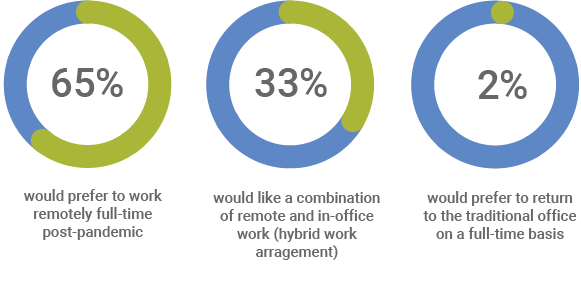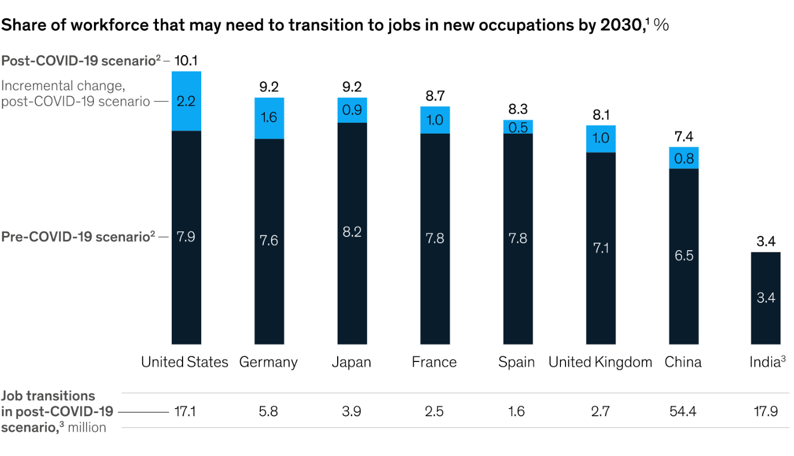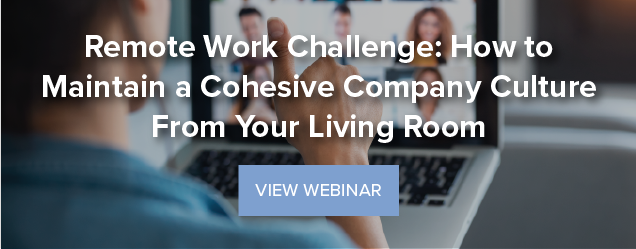
It shouldn’t surprise anyone that the pandemic has permanently changed how we work.
And the changes are far from over.
Workforce industry analysts are predicting some key trends for the future of remote work and hybrid workplaces that will impact where people work and even what they do for work.
But where does employee wellness fit in?
In this blog, we’ll look at predicted workforce changes and what you can do to help your employees further adapt while supporting their well-being.
The Remote (and Hybrid) Workplace Is Here to Stay
Nearly one-third of executive leaders plan to let their office space leases expire and permanently shift employees to working remotely. While this makes sense financially and logistically for many organizations, it’s also in line with what most employees want.
In a 2021 FlexJobs survey, 65% of employees said they want to continue working remotely, 33% prefer a hybrid workplace environment, and 2% want to return to the office. Interestingly, 35% of respondents said they would switch jobs if they were forced back into an office working environment.
 But there’s more to consider.
But there’s more to consider.
Industry experts from Envoy and McKinsey have highlighted some key trends that will require companies to reimagine their policies and practices.
Companies that do plan to remain remote, or move into a hybrid workplace model, still need to consider these changes to how we will work. They’ll have to restructure their organizations to help employees adapt to this new reality.
Two of the starkest trends have to do with job growth and the need to reskill employees.
Job Growth Will Be Based On Skill Level
After a year of working remotely, companies have found creative ways to transition low-wage service jobs online—either through ecommerce solutions, artificial intelligence (AI), or automating tasks altogether.
As a result, the demand for workers in service industries will decrease faster than before the pandemic, and the majority of job growth will take place in industries and positions where advanced skill levels are required. McKinsey predicts that customer service and food service jobs will decrease by 4.3 million, while healthcare and STEM-related jobs will increase.
Workers Will Need to Reskill or Retire
McKinsey made another prediction based on job growth that definitely got our attention: Up to 25% more employees may have to change occupations by 2030 than before the pandemic.
 This statistic isn’t about changing where they work—it refers to changing what they do for a living. That’s going to be a difficult leap for many employees.
This statistic isn’t about changing where they work—it refers to changing what they do for a living. That’s going to be a difficult leap for many employees.
Companies will need to help employees reskill, rethink their career and retirement goals, and deal with the stress and mental health issues that are sure to accompany this shift.
So how can you promote and guard your employees’ wellness as these inevitable changes transpire?
How to Promote Wellness In a Remote/Hybrid Workplace
Workplace stress can negatively impact employee wellness. So, let’s start by looking at how you can restructure your organization to make working easier and less stressful.
Move Your Headquarters Online
Envoy tells the story of how corporate communication platform company Slack moved to an all remote work model and quickly realized that their head office was no longer in San Francisco—it was online. That’s where every employee could be found and accessed.
This type of mindset shift makes it easier for employees to communicate and removes the FOMO that employees have been feeling all year. When everyone is online, all communication and company updates are accessible by everyone. And the opportunity to shine is online and not necessarily in person.
Make Function the Decision Point for Hybrid Workplaces
It’s easy for employees to fall back into old models and assume that anyone working in the office is getting a leg up over remote workers and will be first in line for promotion and other rewards.
Break that cycle by analyzing the work that has to be done in the office and make it clear that in-office work is purely based on function. There may be some work that has to be done in-person. Or perhaps a group project is easier managed if there are regular, in-person working sessions.
Either way, make sure that both management and employees understand that working out of the office is no more admirable than working from home—it is simply another choice that works well under certain circumstances.
Rewrite the Employee Manual
Let’s face it: Most companies were winging it for the majority of last year. No one knew—or really does know—how long the pandemic will truly last. The unintended result is that departments, teams, and employees have been making up their own rules for onboarding, team building, meeting formats, and even where they work.
To make a remote or hybrid workplace effective, you’ll need to “open the hood” on your employee manual and rework your processes to make sure onboarding can be done in person or remotely.
Create guidelines for teams that include team building activities and meeting formats that account for the fact that employees will be participating from multiple locations.
Speaking of location, give some time and consideration to how your company will handle employee self-relocation. Will you allow employees to move to different cities if they are working remotely? Can they travel and work at the same time, or will they have to take time off?
The more clarity you offer, the less stress you’ll create for your employees.
Adapt Wellness Programs for Remote Teams
Whether you are adopting a fully-remote or hybrid workplace, your employees will continue to be separated at least most of the time, which means challenges need to be done remotely.
Choose challenges that lend themselves to this reality. Create challenge groups that promote communication and camaraderie within teams and help improve multi-department processes. Find ways to increase productivity through the rapport and connection that comes from team challenges.
Choose Your Wellness Platform Wisely
If your head office is online, your wellness platform is your employee hub—make sure to choose one that connects everyone and allows for regular communication, updates, rewards and incentives, biometrics tracking, and everything else included in your workplace wellness program.
Use the Meet Up Model
Once it’s safe to do so, schedule “meet ups” for employees near each other—or those willing to commute—to participate in physical challenges together. This can create a welcome change of pace.
On that same note, strive to make your anchor challenge a company-wide meet up. The feel-good experience of being together will help increase participation and positive emotions about wellness and the company.
Beef Up Mental Health Services
The big workplace trends we mentioned might be a tough pill for some of your employees to swallow. As your workplace evolves to a new model, jobs might be lost, transitioned, and re-invented, pulling the rug out from underneath people who are already suffering from the societal instability of the past year or so.
Work-related stress has already been identified as a major contributor to mental health issues, and more changes will only exacerbate the problem. Your employees will need mental health support and services.
Encourage supervisors to check in with their employees during weekly one-on-ones, quarterly reviews, and any time it seems appropriate. In fact, companies need to normalize mental health as a qualitative measure that contributes to overall corporate success. The more comfortable your organization is with the subject, the more likely your employees will seek out and receive the resources they need.
More Ways to Promote Wellness in Remote/Hybrid Workplaces
This is your chance to be creative and make your wellness program foundational to your whole organization. Consider these additional ideas to help in that endeavor:
Give Yourself (and Your Employees) Grace
We’re not talking about accepting mediocrity. That’s not going to help your company achieve its goals. What we do mean is to be patient, manage expectations, and prioritize outcomes as you make adjustments. Recognize that employees (and managers) are human and they’re going to have “off” days, while encouraging openness about the fact that none of you are indefatigable work-machines.
Encourage Purposeful Meetings
We’ve all seen the meme about the meeting that could be an email. Just because everyone has Zoom, doesn’t mean the all-meetings-all-day tradition should carry over to the remote/hybrid workplace.
This is the time to rethink your company philosophy on meetings. Maybe you’ll want to encourage supervisors to create meeting intentions, develop concise agendas, and stick to 30-minute timelines.
Meetings are no longer the universal sign of work. They should have a clear purpose and leave attendees more informed, or they aren’t worth the time.
Promote Healthy Habits
What if your company’s corporate policy promoted wellness in that it expected employees to take care of their health, build in no-screen breaks, and communicate their mental wellness needs regularly?
Imagine the level of happiness and well-being in your organization.
You can do that—you’re already rewriting the employee manual anyway.
Create a Culture of Empathy
More than ever, your employees are struggling with the stress, emotions, and mental health issues related to the pandemic. Some of them may have been diagnosed with depression or anxiety—or both. Most of them need to know that your organization supports them and their needs.
They also need to know that their team members and supervisors support their needs. Your wellness program can include challenges that help foster a culture of empathy and openness.
Make the time and space for employees to be there for each other. You’ll create a supportive culture that inspires engagement, loyalty, and some truly game-changing work.
Whether you choose to move your company to a completely remote model or adopt a hybrid workplace, your wellness program and platform will be key elements to ensure employee engagement, mental health, productivity, and retention.
At WellRight, we help organizations build and rebuild their wellness programs specifically for their unique industries, environments, and employee base. If you would like assistance adapting your workplace wellness program for the next generation of work, feel free to reach out. We’re here to help.




